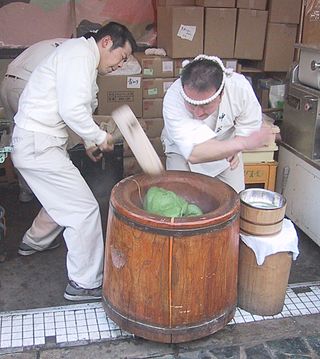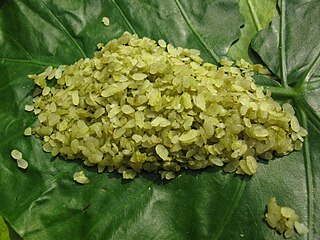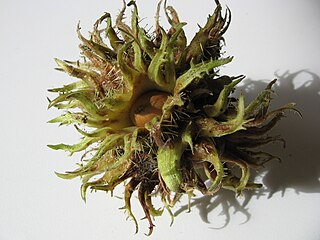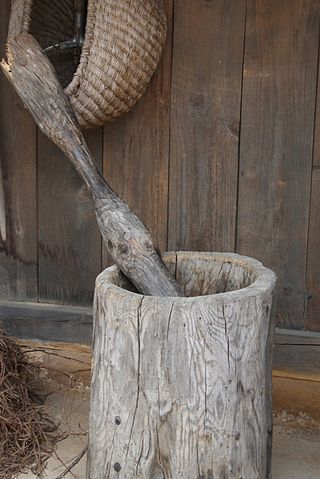
A water wheel is a machine for converting the energy of flowing or falling water into useful forms of power, often in a watermill. A water wheel consists of a wheel, with a number of blades or buckets arranged on the outside rim forming the driving car. Water wheels were still in commercial use well into the 20th century but they are no longer in common use. Uses included milling flour in gristmills, grinding wood into pulp for papermaking, hammering wrought iron, machining, ore crushing and pounding fibre for use in the manufacture of cloth.

A mortar and pestle is a set of two simple tools used to prepare ingredients or substances by crushing and grinding them into a fine paste or powder in the kitchen, laboratory, and pharmacy. The mortar is characteristically a bowl, typically made of hard wood, metal, ceramic, or hard stone such as granite. The pestle is a blunt, club-shaped object. The substance to be ground, which may be wet or dry, is placed in the mortar where the pestle is pounded, pressed, or rotated into the substance until the desired texture is achieved.

Suribachi and surikogi are a Japanese mortar and pestle. These mortars are used in Japanese cooking to crush different ingredients such as sesame seeds.

White rice is milled rice that has had its husk, bran, and germ removed. This alters the flavor, texture and appearance of the rice and helps prevent spoilage, extend its storage life, and makes it easier to digest. After milling (hulling), the rice is polished, resulting in a seed with a bright, white, shiny appearance.

An usu is a large Japanese stamp mill with a pestle called kine, used to pound rice or millet.

A trip hammer, also known as a tilt hammer or helve hammer, is a massive powered hammer. Traditional uses of trip hammers include pounding, decorticating and polishing of grain in agriculture. In mining, trip hammers were used for crushing metal ores into small pieces, although a stamp mill was more usual for this. In finery forges they were used for drawing out blooms made from wrought iron into more workable bar iron. They were also used for fabricating various articles of wrought iron, latten, steel and other metals.
Flattened rice is a type of rice dish made from raw, toasted, or parboiled rice grains pounded into flat flakes. They are eaten as is, toasted, fried, or used as ingredients or toppings for other dishes. Depending on their use, they can be crispy, crunchy, chewy, or soft in texture with a light nutty flavor. They are traditional to many rice-cultivating cultures in Southeast Asia and South Asia. It is also known variously as rice flakes, beaten rice, pounded rice, pressed rice or chipped rice.

A molcajete and tejolote are stone tools, the traditional Mexican version of the mortar and pestle, similar to the South American batan, used for grinding various food products.

A stamp mill is a type of mill machine that crushes material by pounding rather than grinding, either for further processing or for extraction of metallic ores. Breaking material down is a type of unit operation.

A rice huller or rice husker is an agricultural machine used to automate the process of removing the chaff of grains of rice. Throughout history, there have been numerous techniques to hull rice. Traditionally, it would be pounded using some form of mortar and pestle. An early simple machine to do this is a rice pounder. Later even more efficient machinery was developed to hull and polish rice. These machines are most widely developed and used throughout Asia where the most popular type is the Engelberg huller designed by German Brazilian engineer Evaristo Conrado Engelberg in Brazil and first patented in 1885.

Cốm or simply called green rice is a flattened and chewy green rice in Vietnamese cuisine. It is not dyed green but is immature rice kernels roasted over very low heat then pounded in a mortar and pestle until flattened. Cốm is a seasonal dish associated with autumn. It can be eaten plain or with coconut shavings. The taste is slightly sweet with a nutty flavor. It is a popular seasonal dessert across Vietnam, especially in Red River Delta cuisine. It is traditionally produced at the Cốm Vòng village in Hanoi.

The Type 90 is an armoured fighting vehicle produced by Chinese company Norinco; it is the successor for the Type 85 AFV of which it uses some components. The Type 90 series was developed for export, and consists of at least 10 different types; its industrial index is YW535.

Evaristo Conrado Engelberg was a Brazilian mechanical engineer and inventor. He is the inventor of the Engelberg huller, a machine used to strip the husks from rice and coffee during harvest. He was born to German immigrants in Piracicaba, São Paulo.

Colour sorters or color sorters are machines used on production lines in bulk food processing and other industries. They sort items by color, detecting passing items' colors and using mechanical or pneumatic devices to divert items with colors outside the acceptable range or to create distinct groups.

Ciba, also known as nianba, is a traditional Chinese snack made of glutinous rice pounded into paste. It is often molded into shapes of balls or cuboids. Ciba is often fried or steamed before being served.

The Conrad Rice Mill is an independently owned and operated rice mill located in New Iberia, Louisiana, and produces the Konriko brand of rice varieties. Established in 1912, it is the oldest independently owned rice mill in the United States still in operation.

A dheki is an agricultural tool used for threshing, to separate rice grains from their outer husks, while leaving the bran layer, thus producing brown rice. Dhekis have generally fallen into disuse because of the availability of technologies such as combine harvesters that require much less physical labour. In earlier times a dheki was an important part of village life in Bangladesh and in parts of India, notably West Bengal, Jharkhand, Assam and Chhattisgarh. It was generally operated by two or three women.

Pinipig is a flattened rice ingredient from the Philippines. It is made of immature grains of glutinous rice pounded until flat before being toasted. It is commonly used as toppings for various desserts in Filipino cuisine, but can also be eaten plain, made into cakes, or mixed with drinks and other dishes.

Husk in botany is the outer shell or coating of a seed. In the United States, the term husk often refers to the leafy outer covering of an ear of maize (corn) as it grows on the plant. Literally, a husk or hull includes the protective outer covering of a seed, fruit, or vegetable.

Jeolgu (절구) and gongi (공이) are a type of traditional Korean mortar and pestle set, used for pounding grains or tteok. They can be made with timber, stone, or iron. Jeolgu is a bowl-shaped vessel in which grains or tteok can be pounded, and gongi refers to either a pestle for a mortar or a stamper for a stamp mill.




















